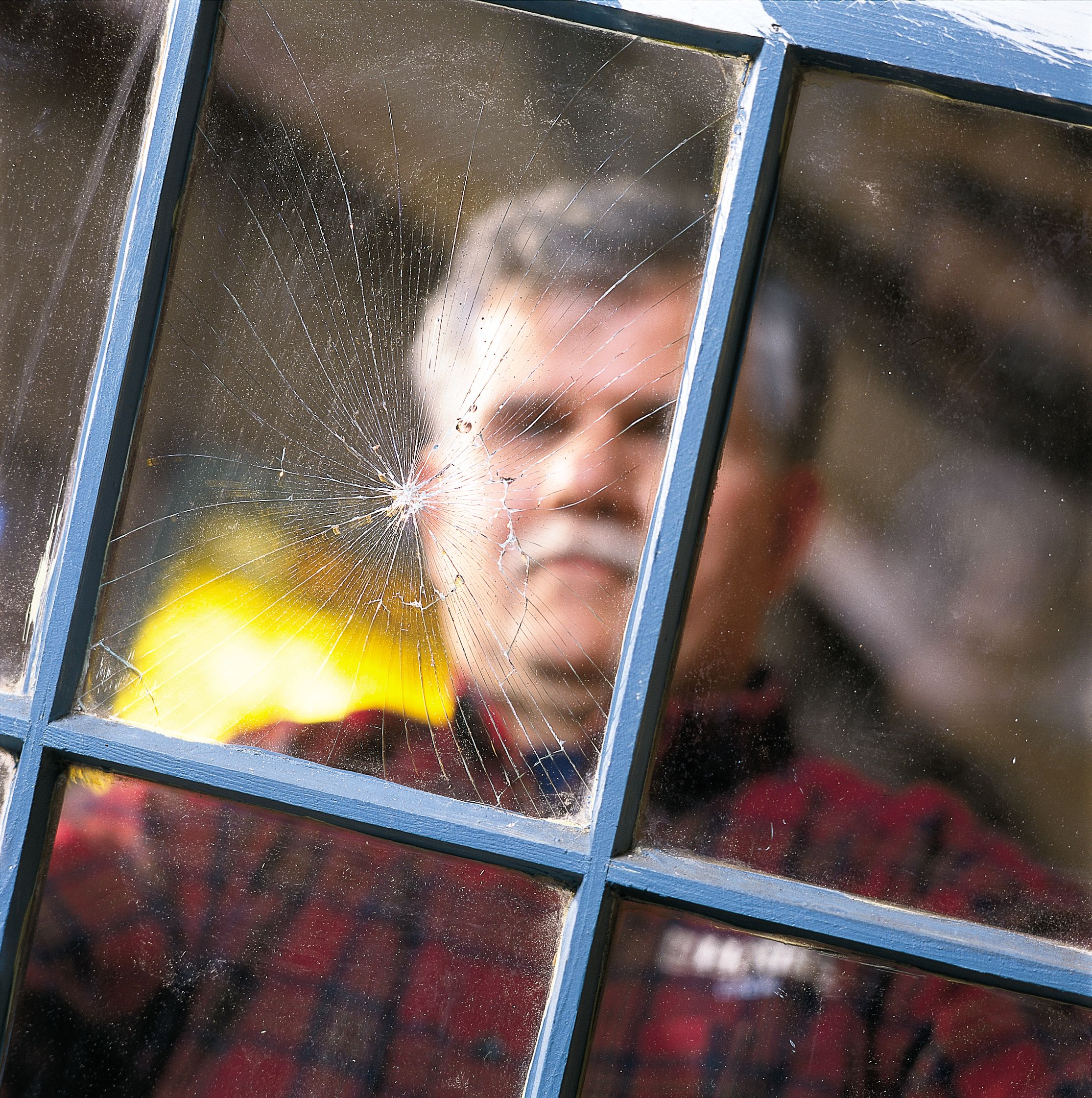We may be compensated if you purchase through links on our website. Our team is committed to delivering honest, objective, and independent reviews on home products and services.
Project details
Skill
Cost
Estimated Time
Replacing a broken window pane is a manageable DIY project that can save you money and fix drafty rooms. Whether you’re dealing with a cracked pane from an errant baseball or deteriorating putty in an old single-glazed wood sash, this guide will walk you through the process step-by-step.
With the right tools, materials, and a bit of patience, you can successfully replace a window pane and improve your home’s energy efficiency. This project is particularly suited for older, single-glazed windows, but these techniques also apply to more modern windows.
Understanding Window Pane Replacement
Before diving into the replacement process, it’s important to understand the basics of window panes. This knowledge will help you determine whether you can handle the project yourself or if you should use professional assistance.
Types of Window Panes
Window panes come in the following types:
- Single-pane: The simplest type, consisting of a single layer of glass.
- Double-pane: Two layers of glass with a sealed air space between them for better insulation.
- Triple-pane: Three layers of glass for maximum energy efficiency.
- Low-E glass: Coated to reflect heat and improve energy efficiency.
- Tempered glass: Specially treated to be stronger and safer if broken.
For older homes with single-pane windows, replacement is usually straightforward and can be a DIY project. However, modern double or triple-pane windows typically require professional replacement due to their complex construction.
When Replacement Is Necessary
Several situations may call for window pane replacement:
- Cracks or chips in the glass
- Drafts or increased energy bills due to poor insulation
- Foggy appearance between double-pane glass (indicating seal failure)
- Outdated or inefficient single-pane windows
If you notice any of these issues, it’s time to consider replacing your window pane. With a single-pane window, you can probably do this without replacing the entire window frame, saving both time and money.
Tools and Materials Needed for Window Pane Replacement
Having the right tools and materials is crucial for a successful window pane replacement. Having everything on hand before you start will make the process smoother and more efficient.
Essential Tools
- Chisel
- Glass cutter (if cutting your own glass)
- Hammer
- Heat gun
- Measuring tape
- Paintbrush
- Putty knife
- Safety glasses and gloves
- Sandpaper
Required Materials
- Exterior paint
- Exterior primer
- Glazier’s points
- Glazing putty
- New glass pane (cut to size or slightly smaller than the opening)
- Rags for cleanup
Safety Precautions When Replacing a Window Pane
Safety should be your top priority when replacing a window pane. Working with glass and potentially old materials requires careful handling and proper protection.
Protective Gear
Always wear safety glasses to protect your eyes from glass shards and debris. Heavy-duty gloves help prevent cuts when handling broken glass or working with the window frame. Long sleeves and pants can provide additional protection for your skin.
Handling Broken Glass
When dealing with a broken pane, cover it with a cloth or rag before tapping it with a hammer to loosen the shards. This step prevents glass from flying and reduces the risk of injury. Dispose of broken glass carefully in a sealed container marked “Broken Glass” to protect waste handlers.
Step 1
Remove the Glass
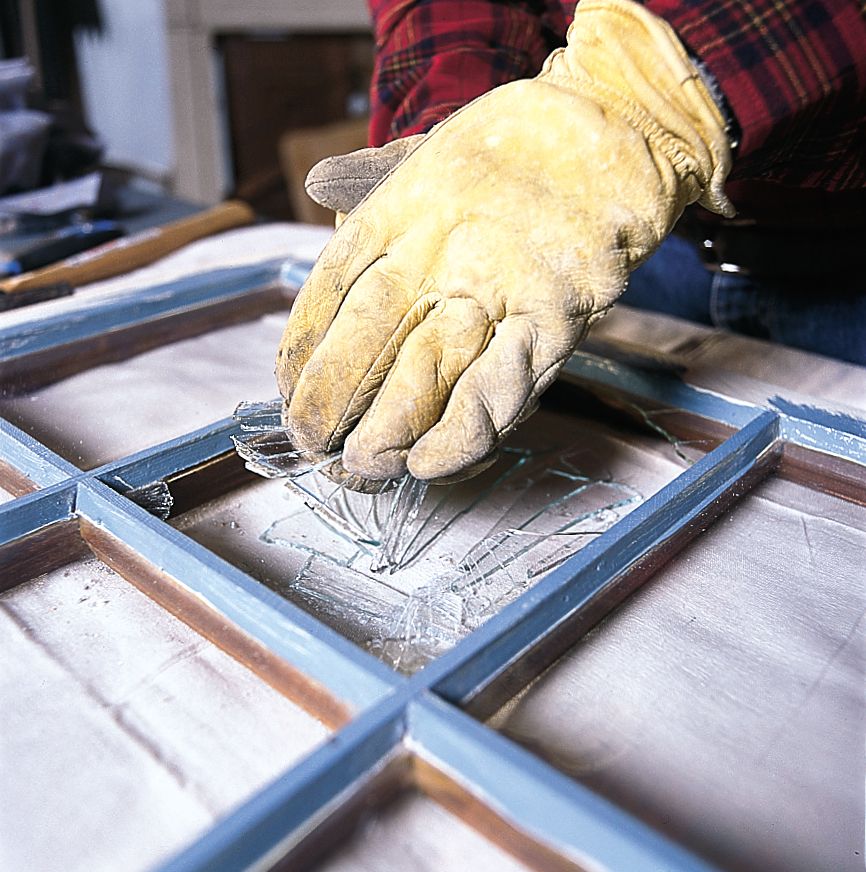
Wear gloves and safety glasses, and cover the broken pane with a rag. Tap the center of the rag-covered pane with a hammer to loosen the shards.
With gloved hands, wiggle free any pieces that remain embedded in the putty.
If the sash is still in the window opening, or the pane has a crack or two but is otherwise intact, we recommend removing the putty first, then the glass.
Step 2
Remove the Old Putty
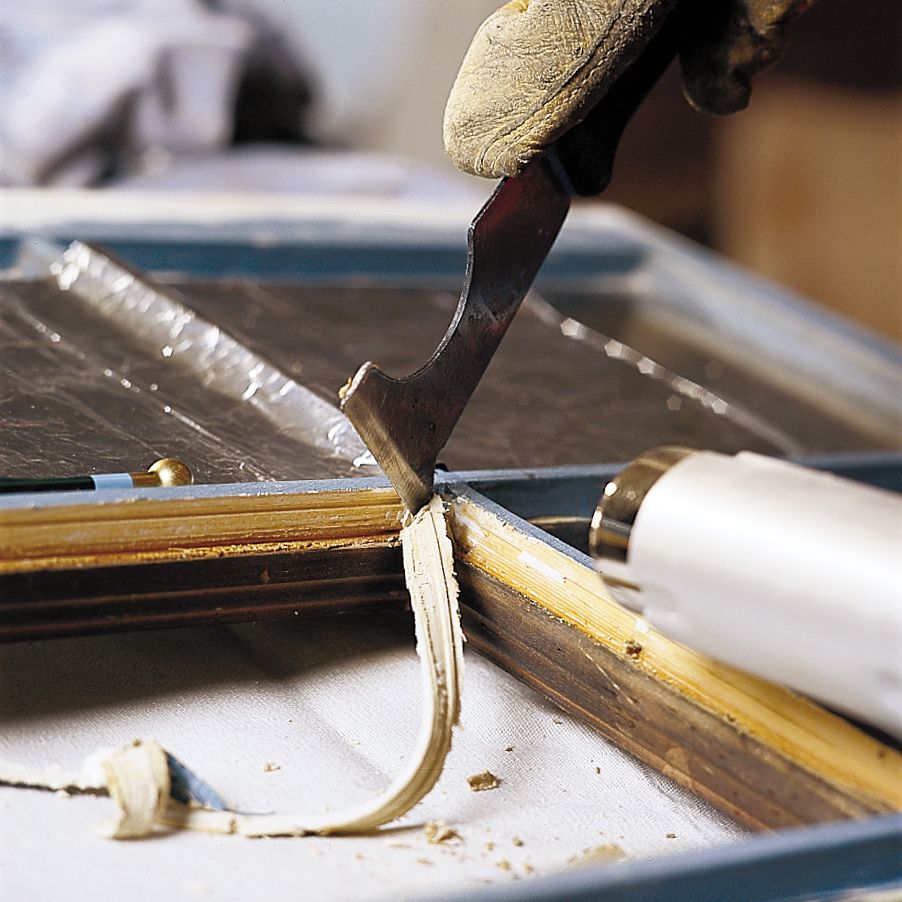
Pry out any loose putty with a painter’s tool. Gradually soften the intact putty by holding a heat gun about an inch away and moving it back and forth.
Put doubled sheets of aluminum foil on the adjacent panes to keep them from being cracked by the heat.
Use the chiseled point of the tool to rake out the warm putty. Repeat on the remaining sides.
TIP: When removing putty from an intact pane, Tom holds a piece of metal flashing over the glass to dissipate the heat.
Step 3
Prep the Rabbets
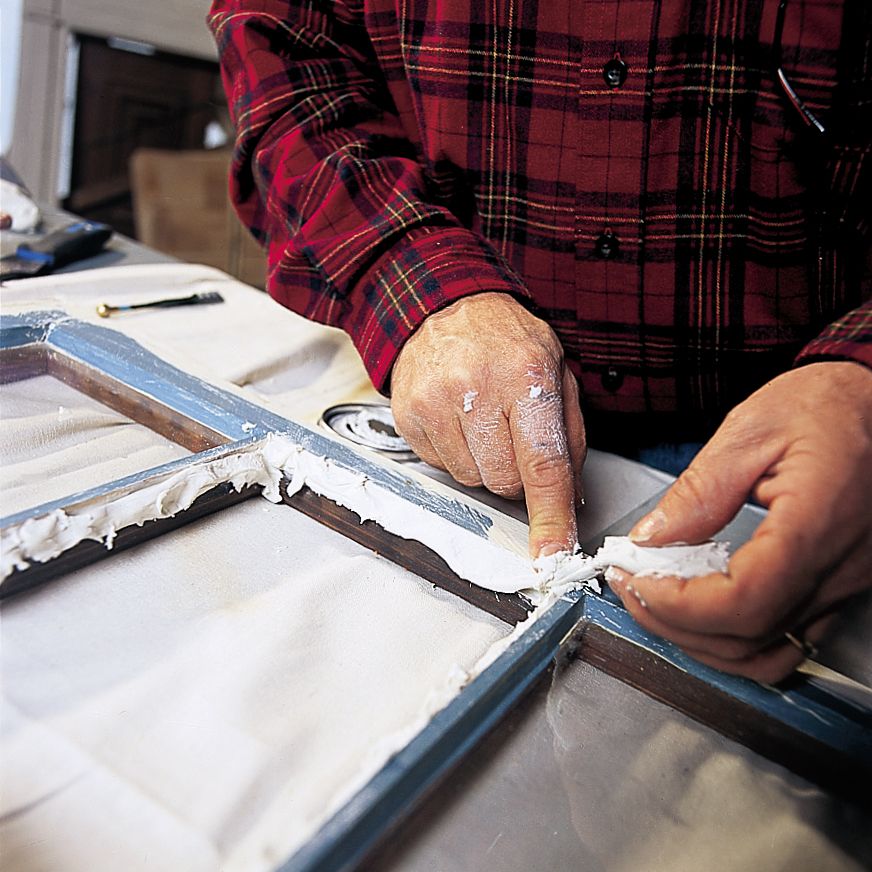
Pry the old metal glazing points out of the rabbets, the grooves in the sash where the glass sits.
Scrape and sand the rabbets down to bare wood. Brush an exterior primer onto the bare wood so it won’t draw the oils out of the putty and shorten its life.
When the paint dries, knead a handful of putty until it’s warm and malleable, then press it into the rabbets, filling them completely (as shown). Neatness doesn’t matter at this stage.
Step 4
Bed the Glass
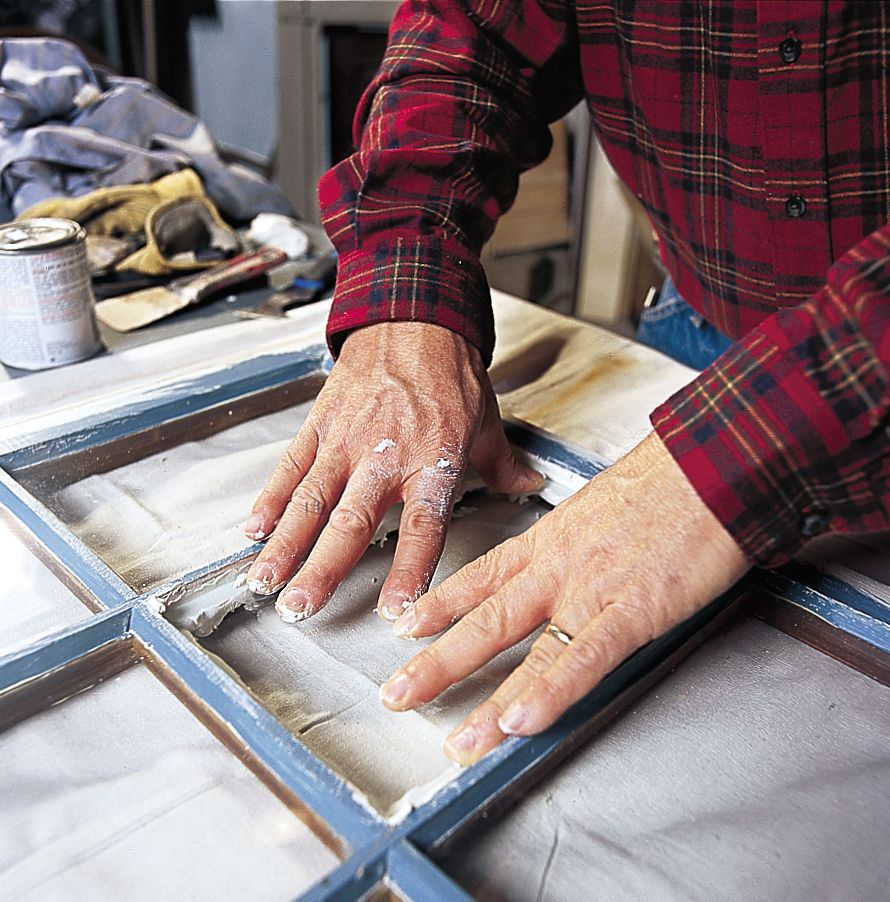
Wiggle the pane into the putty while applying even pressure with your fingertips.
Continue pushing down until the glass is centered in the opening and about 1/8 inch of putty remains between the face of the glass and the rabbet.
If any voids show under the glass, pull out the pane, add more putty, and start over.
Step 5
Set the Points
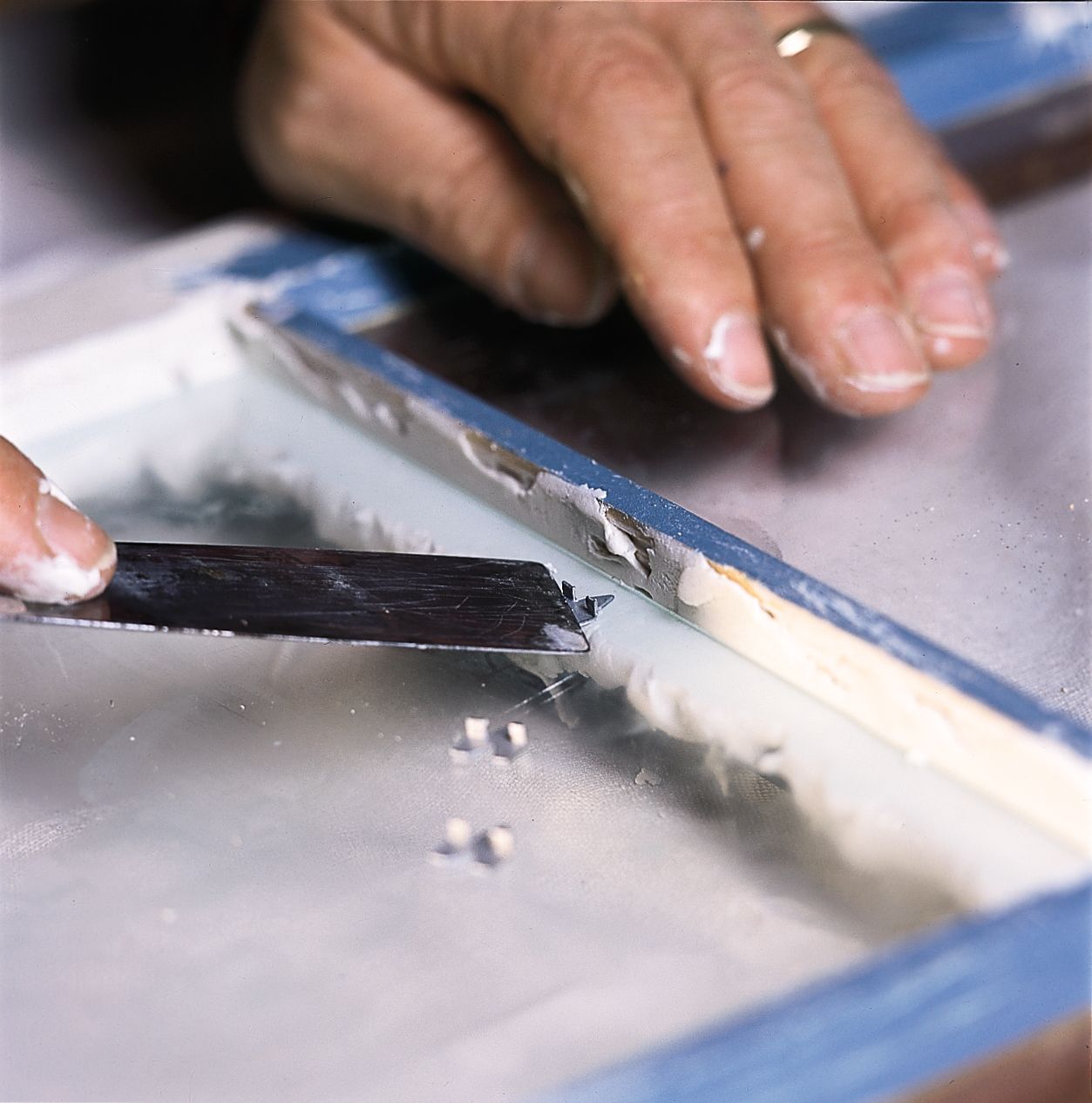
Place a glazier’s point flat on the glass at the center of each side of the pane and fit the tip of the putty knife against the point’s raised shoulders.
While applying slight downward pressure, gently rock the point from side to side until it’s seated in the wood.
Repeat on the opposite side and then on the two remaining sides. For panes 12 inches or longer on a side, space the points evenly 4 to 6 inches apart.
Flip the sash over and scrape off the excess putty that squeezed out the other side.
Step 6
Knead the Putty
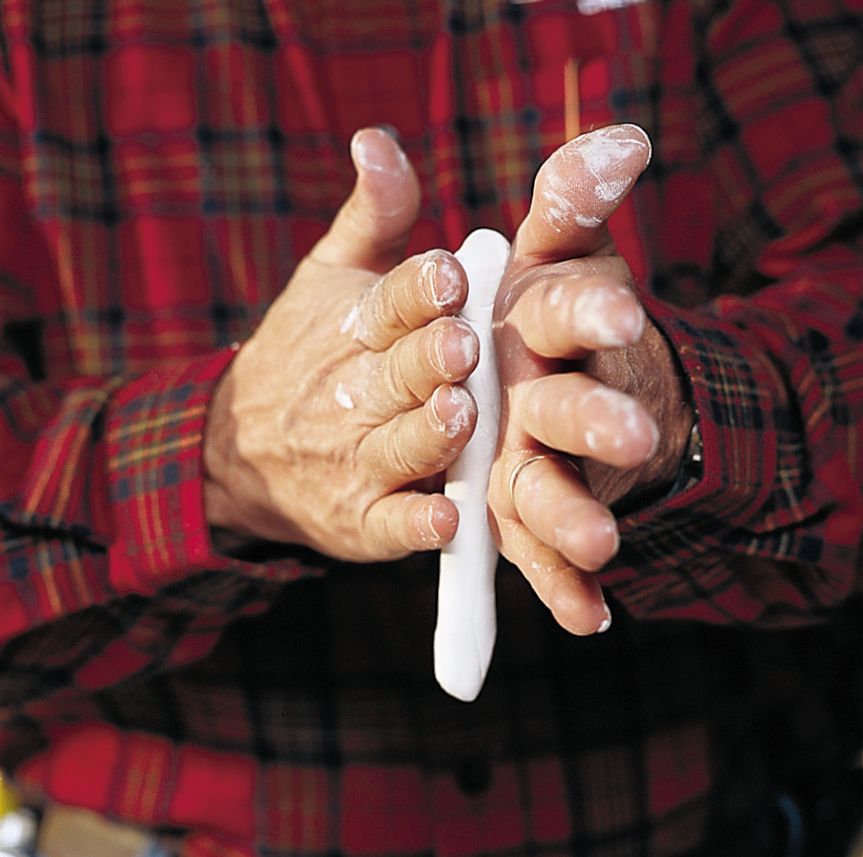
Warm a handful of putty and roll it into a long rope about ¾ inch in diameter.
Step 7
Apply Putty Rope

Place the rope around the edges of the glass and push it firmly against the exposed rabbets.
If one rope isn’t enough, roll out more and overlap the ends to form an unbroken ring of putty around the edges of the glass.
Step 8
Smooth the Putty
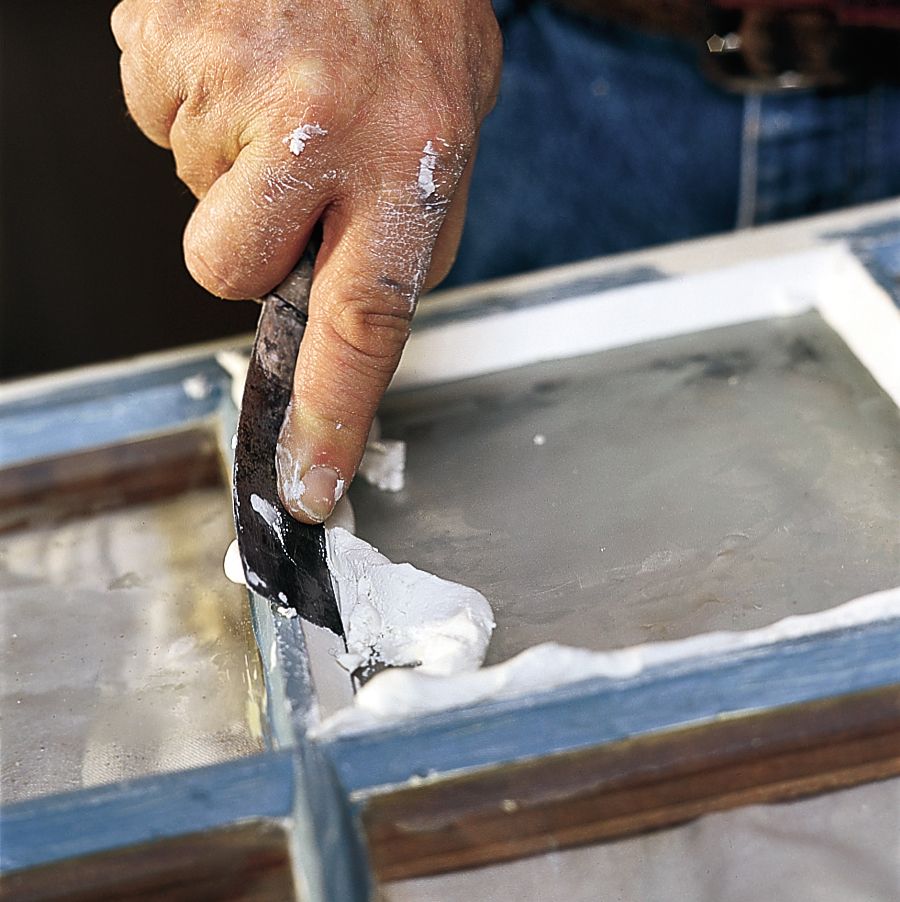
Starting in a corner, rest the putty knife’s blade at about a 45-degree angle to the glass, with its tip on the top edge of the rabbet and one corner on the glass.
Flatten the blade against the putty with your index finger and maintain the angle as you pull the knife along one side of the pane. Leave a neat crease in the corner — then collect the excess putty.
For the remaining sides, set the blade tip on the crease and repeat the tooling process.
TIP: If the knife pulls the putty off the glass, clean the blade and try again.
Step 9
Fine-tune
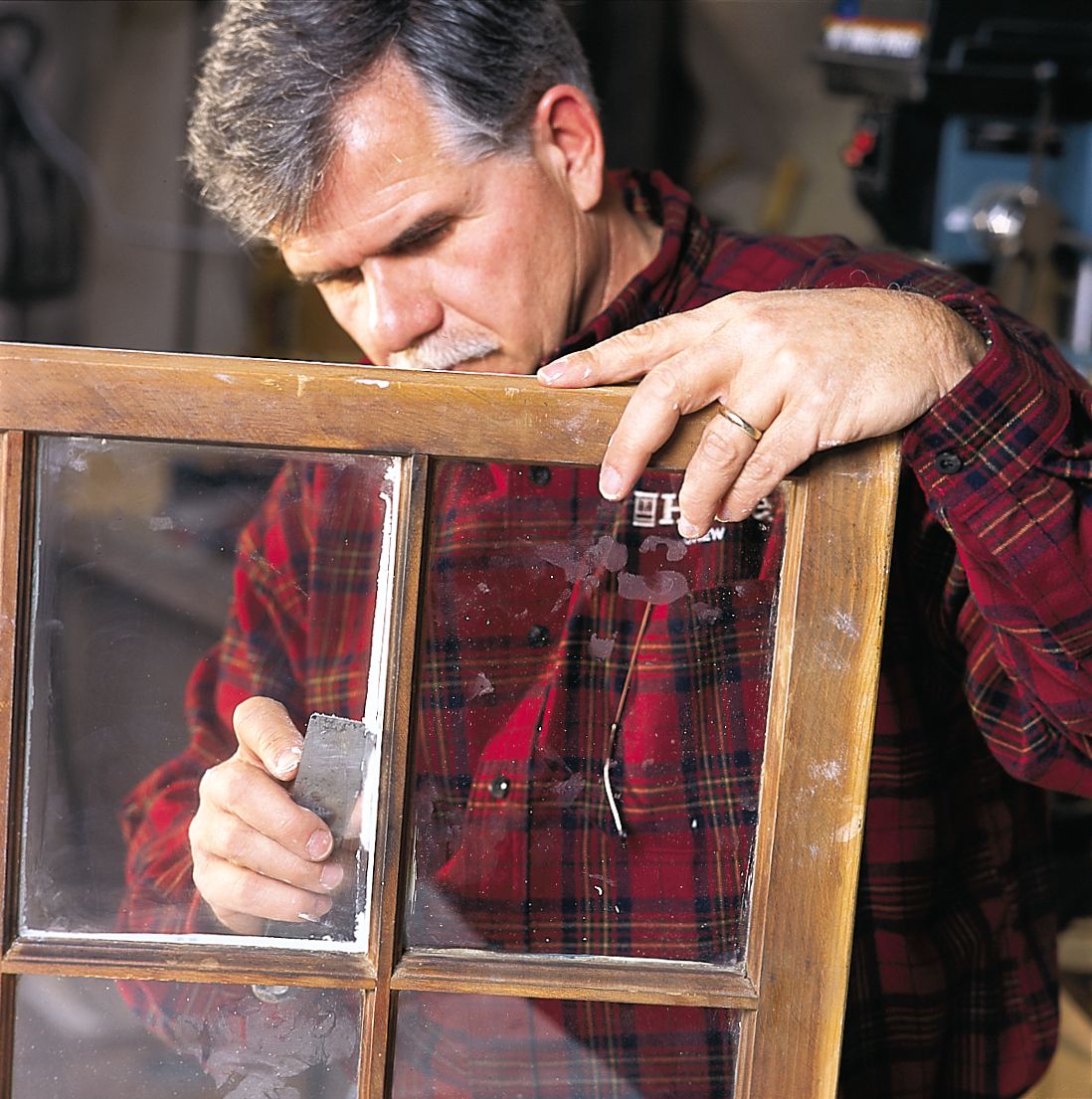
If the underside of the putty can is visible from the other side of the window, the putty application is too wide and requires some retooling.
Set the corner of the blade on the glass a little closer to the rabbet than before, and hold the knife handle slightly closer to the glass.
Retool as in Step 8. You’ll know you’ve gotten the angle right if the putty’s edge lines up with the inside edges of the sash or muntins for a proper repair on the opposite side of the window.
Scrape away the excess (as shown above).
Step 10
Prime and Paint
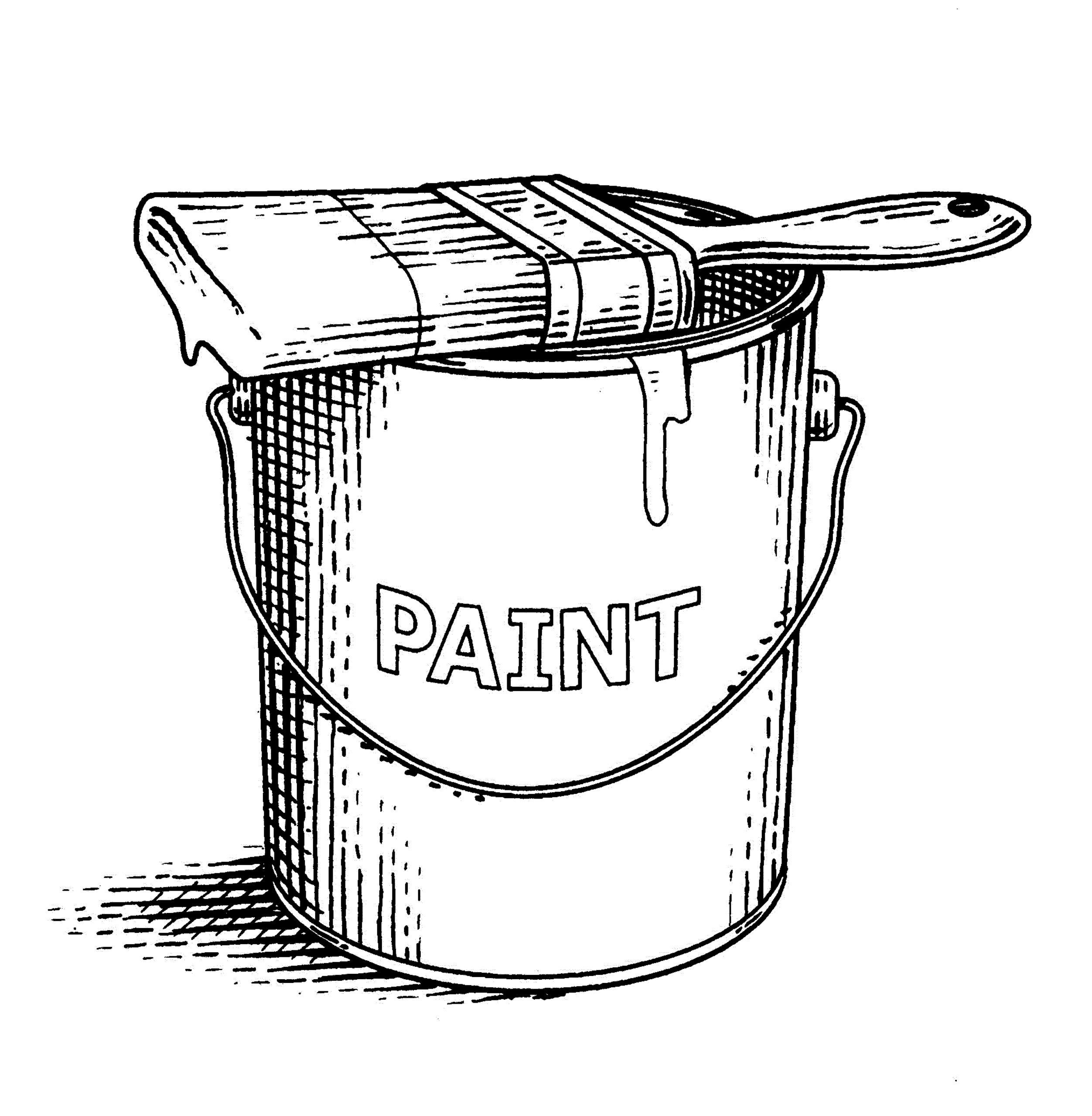
Wait about seven to ten days for the putty to stiffen up, then clean the oily putty film off the glass with a dry rag.
Paint the putty with an oil-based primer, overlapping it about 1/16 inch onto the glass to prevent water from getting behind it.
After the primer dries, apply a coat of exterior paint.
When the paint dries, you can give the pane a thorough scrubbing.
Troubleshooting Common Window Pane Replacement Issues
Even with careful preparation and execution, you may encounter some challenges during the window pane replacement process. Here are some common issues and how to address them.
Dealing with Oversized Glass
If your new pane is slightly too large for the opening, you can carefully trim it to size. Use a glass cutter to score the edge of the pane, then gently snap off the excess. Always wear protective gear when cutting glass and work on a flat, stable surface. If you’re not comfortable cutting glass, it’s best to return to the supplier for a correctly sized piece.
Fixing Putty Imperfections
Sometimes, the putty may not look perfectly smooth after tooling. If you notice any gaps or unevenness, you can touch up these areas within the first day or two after application. Use a small amount of putty on your finger to fill in gaps, then smooth with a putty knife. For larger imperfections, you may need to remove the putty from that section and reapply it.
Maintaining Your New Window Pane
Proper maintenance can extend the life of your newly replaced window pane and prevent future issues.
Regular Cleaning Tips
Clean your windows regularly with a mild soap and water solution or a commercial glass cleaner. Avoid using abrasive materials that could scratch the glass. When cleaning, inspect the putty for any cracks or signs of deterioration.
When To Consider Professional Help
While many window pane replacements can be DIY projects, there are times when professional help is advisable. Consider calling a professional if:
- You’re dealing with large or oddly shaped windows
- The window frame shows signs of rot or damage
- You’re replacing panes in double or triple-glazed windows
- You’re not comfortable working with glass or at heights
Professionals have the tools and expertise to handle complex replacements safely and efficiently.
Window Pane Replacement Cost Considerations
The cost of DIY window replacement will always be cheaper than hiring a professional. However, the cost of replacing a window, even with a professional, will be less expensive than the costs you can incur from a broken window, such as water damage and pest intrusion.
DIY vs. Professional Replacement
DIY replacement of a single-pane window pane typically costs between $75 and $600, including materials. The main expenses are the glass pane, putty, and any tools you might need to purchase.
On the other hand, professional replacement of a single-pane window pane can range from $175 to $900 per window, depending on the size and complexity of the job. The cost of a professional double-pane window replacement is typically between $250 and $1,200. Triple-pane windows will cost almost double the amount of double-pane.
Prices for this article sourced from Angi.
Factors Affecting Cost
Several factors can influence the cost of window pane replacement:
- Accessibility of the window
- Condition of the window frame
- Local labor rates (for professional installation)
- Size of the pane
- Type of glass (tempered, low-E, etc.)
Our Conclusion
Replacing a window pane is a practical skill that can save homeowners money and quickly restore their windows’ functionality and appearance. While it requires patience and attention to detail, the process is manageable for most DIY-minded homeowners, especially when dealing with single-pane windows in older homes. By following the steps outlined in this guide, you can successfully replace a broken pane and even trim an interior window if needed.
Remember that safety should always be your top priority when working with glass. If you’re unsure about any part of the process or dealing with more complex window systems, don’t hesitate to seek professional help. Whether you choose to tackle the job yourself or hire a pro, replacing a damaged window pane is an investment in your home’s comfort, energy efficiency, and overall value.
Tools Needed
Tools & Materials
 putty knife – 1/2-inch
putty knife – 1/2-inch 5-In-1 Painter’s Tool
5-In-1 Painter’s Tool Heat gun
Heat gun Sash paint brush – 1-inch
Sash paint brush – 1-inch
